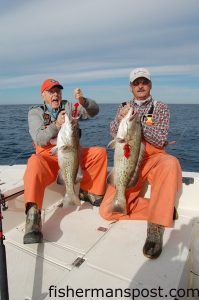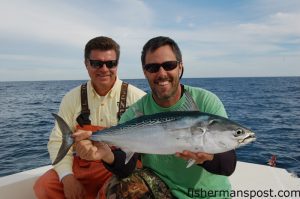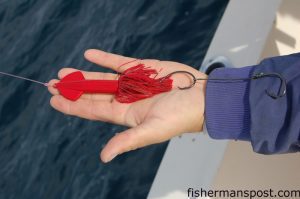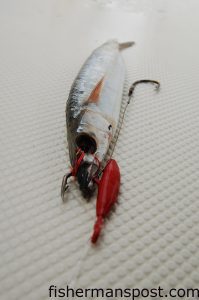My Squid’s Gone Barefoot

John (left) and Barry Bobbitt, the father and son team that respresented "experience" on the product review fishing trip, with a couple of gag grouper caught 12 miles out on the new Squid Decoy system by Barefoot Fishing. John's gag fell for a live cigar minnow, and Barry's hit a grass grunt.
“You know what an engine needs? It’s fuel, fire, and air. Well, you know what Tim Barefoot needs? Fuel, bait, and ice,” were the smiling words that Capt. Tim Barefoot greeted me with on a chilly pre-dawn morning at Masonboro Yacht Club and Marina.
Friends of Tim know that he brings a lot of energy and passion to fishing and his fishing business, and this December morning his energy was very contagious as I handed him my sandwiches, water, and camera gear. Our mission for the day was to try out a couple of Barefoot Fishing products: the Squid Decoy, a deep water version of the Crab Decoy jig, and his new Chin Weight.
We would be heading off the beach looking for water warm enough to hold kings so we could first try out the Chin Weight, and on the way out to 69 degree water we’d keep an eye on his electronics and save marks to bottom fish on the way back in.
Tim puts a big emphasis on pretty bait, so our first stop of the day was the 10 Mile Boxcars where Barry Bobbitt (Tim’s long time fishing buddy who had also brought his father John Bobbitt along today) and Taylor Barefoot (Tim’s 16-year-old son) began to work the sabikis. They used the bait catching time as an opportunity to show off their fish identification skills.
Me? I used the time to run my mouth and try to create a little Youth versus Experience competition. I challenged each of them to tell me what they had on the sabiki before bringing it up out of the water.
“I got two cigar minnows,” Barry calmly predicted as he steadily reeled up with a rod tip telegraphing very quick and repetitive twitching action. When he brought up his sabiki, Barry smiled and held the rod out to Tim waiting with a small dehooker standing over a 5-gallon bucket in the back of the boat. On Barry’s sabiki was exactly two cigar minnows.
I immediately looked to Taylor to match Barry’s call.
“I’m going to say one cigar minnow,” countered Taylor while he reeled in, and he, too, was soon pleased to see that he had the correct call.
The next 20 minutes saw Barry and Taylor going back and forth on what was hooked on the sabiki. The duo were rarely off by more than one fish, and that included identifying the different species that the sabikis found that day, such as small sea bass, sardines, and grass grunts.
While Youth made a very respectable run (Taylor’s highlight reel included a couple of full houses—six cigars), it was Experience that ultimately took the bait title. Barry continued to correctly call just about everything on that sabiki, including a foul-hooked sea bass (with the same sabiki hook in its mouth that Barry had lost two casts prior) and a four cigar minnow call that included “one that was a little lackadaisical.”
We loaded the livewell, but Tim’s favorite was easily the sardines. “The grouper know there’s not a fin on them that can hurt them, and they’re full of that high protein fat. It’s irresistible,” he told me as we pointed the boat east and headed out in friendly 1-3’ seas and a light southwest breeze. This was a “blue bird” December morn, and all five of us couldn’t keep from noting our good fortune with bait and weather, as well as our high hopes for the day.
We found our king mackerel water at about 20 miles out in 80’ of water. The seas were friendly, but the run was hard. It was hard for all of us to have a well full of pretty live baits and pass over gag grouper country. The electronics had given us several temptations to stop. We had a plan, though, to see the Chin Weight in action, so we passed ledges, scratches, and reliefs and saved them for the run back in.
Barefoot Fishing’s Chin Weight, our first product to test that day, is a weighted hook (it comes wth both circle hook and j-hook models) made for trolling ballyhoo, squid, and other baitfish. The weighted hook keeps the bait keeled, upright, and swimming pretty.

Capt. Tim Barefoot (left), of Barefoot Fishing, and Gary Hurley, of Fisherman's Post Newspaper, with a bonito caught on a ballyhoo rigged with Barefoot Fishing's new Chin Weight. They were fishing 80' of water about 20 miles out of Masonboro Inlet.
Tim was eager to get fishing, and he quickly set out a line and handed me the rod to hold while he worked on a second line. While Tim was explaining to me how easy and quick it is to rig a ballyhoo on the Chin Weight, my clicker started screaming and I looked up to see the tail end of an explosion where my ballyhoo had just been swimming.
“I think the Chin Weight works,” I said with a smile, feeling lucky that the rod happened to be in my hands when the first strike of the day had come.
My fish took a couple of nice runs and we were hoping for a good-sized king, but then I felt a couple of head shakes. Tim, like all good captains, didn’t have the rod in his hands but knew before I did what the head shake meant. “It’s a bonito,” he called as I wound in furiously while my fish now headed straight for the boat.
We took a few photos, released the fish, and then Tim went back to telling me about his Chin Weight rig.
“It sure looks good in the propwash with a flatline clip. It looks good with no skirt, no nothing,” he beamed proudly as we watched a new bait swim hard just 8’ off the stern of the boat. It had taken him no more than 30 seconds to rig the ballyhoo. First, he broke off the bill, removed the eyes, and limbered up the ballyhoo. Then he brought the hook up under the chin and out through the center of the nose. To finish, he took a little wire and wrapped it about three times through the eyes and around the hook.
The Chin Weight comes in three sizes: king mackerel size, wahoo size, and bluefin tuna/blue marlin size.
Today we were using the king mackerel size, which has a 7/0 hook with 11/16 oz. of weight attached, and a 7/0 stinger (the stinger hangs free—he doesn’t attach it to the bait so the bait swims unhampered). Tim ties a fluorocarbon leader straight to the jighead, and today we were trolling about 6 knots.
“With a traditional ballyhoo rig,” explained Tim, “the hook comes out in the belly and that’s where your action starts—it keeps the body more rigid; however, with the Chin Weight rig the action starts right behind its gills and that’s why the action is so nice. The whole fish is undulating instead of just the back half.”
My first bonito was my last bonito. We caught several others, but Taylor was always the first to the rod when it starting screaming. I’m not sure if it’s because Youth wins out over Experience when it comes to speed, or if it’s that the Experience on our boat didn’t care much about bonito and just wanted to start grouper fishing. Either way, it was time to put up the trolling outfits and start hitting some marks to try out the second product of the day, Barefoot Fishing’s new Squid Decoy.
“This is another one in the family of the Decoy jigs. It’s like the Crab Decoy but looks like a squid, and you will be the first writer to ever catch fish on this jig,” said Tim holding up a 6 oz. red Squid Decoy. I’m just happy to have an opportunity to go grouper fishing, but being the first media guy to try the product added to the growing anticipation.
The Squid Decoys also come in 9 and 12 oz. sizes, but for 60-70’ of water and a light tide we would only need the 6 oz. model to get our baits to the bottom.

Barefoot Fishing's new Squid Decoy comes in both a circle hook (pictured) and a j-hook model.
While the original Crab Decoy is made for 125’ of water and under, the Squid Decoy is made for just about any water depth. The Decoy systems, like the Chin Weights, come in either a j-hook or a circle hook style, but today Tim wanted me to fish the new circle hook model. He explained that in part the circle hook model came about out of necessity—the snapper/grouper fishery off Florida’s west coast requires only circle hooks, so to sell tackle in this area he had to make the circle hook option available. The circle hooks worked so well, though, that he fishes them exclusively, including here off of the North Carolina coast.
“The Decoy jigs are simply vehicles to get bait to the bottom,” he told me as he checked his scope and wind direction to anchor up over the first spot, “and with the circle hook you don’t have to set the hook. The Squid Decoy is truly the cutting edge of circle hook jigs.”
The Squid Decoys we would be fishing today had a 9/0 main circle hook and an 8/0 stinger attached with 250 lb. Power Pro doubled up (just like the j-hook version). And like the Original Crab Decoy, the stinger will 9 times out of 10 be the hook that closes the deal with the would-be bait stealer.
So I’ve put in some dues when it comes to bottom fishing, but I often struggle with getting the rhythm and feel down. I go through periods where my bait gets robbed as soon as it hits the bottom and there doesn’t seem to be anything I can do about it. I’ve also gone through periods where I feel like I’m getting hit but missing the hook set, or I get hooked but then get rocked. My bottom fishing technique, at best, is a work in progress.
I told Tim that I didn’t consider myself an accomplished bottom fisherman, and I was looking for advice on how to best set the hook with the Squid Decoy.
“All you do is when you feel the bite, start slowly winding,” he explained. “That’s the way you fish circle hooks, and this rig is custom made for it. Slow wind until you feel that solid hookup, and then get on it. Do whatever you need to do to get him up.”
To warm me to bottom fishing with circle hooks, Tim had me start with dropping down squid and targeting some smaller fish.
Along with the squid, he gave me reminders to reel up slowly and not jerk the rod.
The Squid Decoy worked immediately with squid on the smaller fish. Within a few minutes I had put a handful of large grunts and some reasonable-sized sea bass over the rails. Apparently I was a good student, resisting the temptation to “set” the hook and let the hook do the work. My trial was over, and Tim thought I was ready to go with some live cigar minnows to target grouper.

A ballyhoo rigged with Barefoot Fishing's new Chin Weight.
As soon as we dropped the pretty live baits, the bigger fish responded. On my first drop with a cigar, I hooked an under-sized gag. I felt the tug, smoothly lifted my rod and winded, and the gag soon came up and over the rails with the circle hook stinger in the corner of its mouth. I was enjoying being the first writer to catch a gag on the new Squid Decoy.
And while I was busy patting myself on the back, Experience was catching keepers.
“Keep the pressure up and don’t let him rock you,” said Tim to John, Barry’s 80+-year-old father who was fishing in the back corner of the boat, not standing but sitting to better keep his balance. He had the limelight to himself for only a second, though, as Barry’s rod doubled over with what was clearly another bigger fish.
Tim, Taylor, and I watched as the father and son team brought up a pair of 10 lb. gags. John doesn’t get out on the water as much as he would like to these days, so the double hookup was an especially “feel good” moment. John’s gag had fallen for a sardine, Barry’s had hit a grass grunt, and both had Squid Decoys hanging from their mouths. To say the least, Tim’s product review was going well.
Like any good businessman, Tim wants to sell you on his products—Decoy Jigs and Chin Weights—but he’ll also tell you that he’s trying to sell you on his overall approach to bottom fishing.
He’s a big believer in using good bait (he welcomes the butterfly jiggers in a head to head competition at any time), anchoring up and not drifting, and using his more ergonomically designed tackle.
First, he expounded on his thought concerning bait versus butterfly jiggers, “I’m trying to attract grouper, not amberjacks, and I’m fishing specifically for grouper with meat. Amberjacks respond better to metal. Grouper respond much better to live or dead bait. Grouper won’t hit those deep water jigs bouncing off the bottom like you think. They may hit some out of irritation, but they’re meat eaters. The Decoy jigs present grouper with meat.”
Second, he stresses how anchoring, and not drifting, is the way to produce results. “What I’m trying to do is get people acclimated with anchoring,” he explains. “You can drift all day, but when you’re drifting you’re constantly changing. You’re not sitting on fish that you can really get rallied up. When you anchor in one place and have everything straight up and down over and over and over in the same spot, that’s what works. And the reason to start with the squid is to have everybody on the boat fire down squid, after squid, after squid, and get an area down there on the bottom that’s stinking like squid and getting all the fish around excited.”
Finally, he addressed how the Squid Decoys not only produce fish but make for an overall more enjoyable day on the water.
“I’m not standing there all day holding a 16 oz. bank sinker and bulky equipment,” he explains. “I’ve scaled it back so I can send my tackle down 100 times a day and I’m not exhausted. I’m tired after a day of fishing but not exhausted.”
His style clearly works. We were dropping jigs made of only 6 oz. of lead. The lightweight Daiwa Saltist reels were mounted on 5.5’ Barefoot rods (made of 50 lb. class live bait tuna blanks) and filled with 65 lb. braided Sufix line. The combo was very responsive and easy to handle. My bait was on the bottom, I had enough muscle to bring fish up, and I never got tired by reeling up to check on a bait.
John and Barry took some quick photos (these photos are always a nervous time because you don’t want to stop catching fish to take a photo, but when you’re doing an article you have to have the photo), and then we dropped down some more baits and continued catching two more keeper gags and a couple more under-sized ones.
John and Barry, the oldest pair on the boat, easily walked away with the grouper title, so put another one down to Experience. Taylor and I were the youngest pair and only dominated the bonito division. I didn’t care, though, as I was just happy to be considered young.
The big winner—Barefoot Fishing’s Squid Decoy and Chin Weight. Both products produced fish in less than three minutes in the water.
For more information or to order the Decoy Jigs and Chin Weights, you can call Tim at (910) 617-7637, or go online and visit www.barefootfishing.net.
